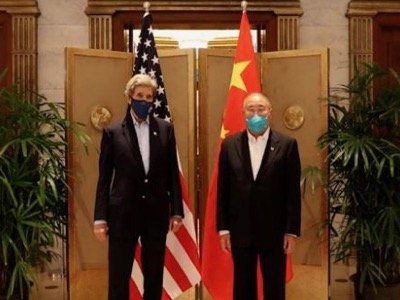By: Duncan McFarland, Chair China/Asia Subcommittee, CPUSA
Introduction: The U.S. and China—A Critical Relationship
The official COP26 website displayed in a banner headline the goal of the Glasgow, U.K. mega-conference: “Uniting the World to Tackle Climate Change.” In 2015, the Paris conference had united the world on the principle of tackling climate change, as most every country signed the pledge; now at Glasgow, further targets would be set and plans made to do a much better job of actually implementing the Paris principles. However, as it turned out, in Glasgow uniting the world to do anything with major practical impact did not happen. Some lesser agreements will be productive if actually implemented, but the sum total of efforts will still fall way short of what is needed to contain climate devastation due to global warming. Perhaps the best news is the plan to reconvene next year with more ambitious targets.
From the perspective of U.S.-China relations, it was hoped that the two countries would be able to cooperate in connecting a world united to tackle climate change. An agreement between the U.S. and China, as the two biggest economies and users of energy, would go a long way towards constructing a stronger global response. There were positive indicators: China and the U.S. had worked together at the historic Paris climate meeting in 2015 and both countries officially have long stated they want to cooperate on climate change. Most of the membership and constituency of the Democratic Party supported climate change action, and cooperation with China on this issue was included in the Democratic Party platform of 2020. President Biden made a prestigious appointment, former Secretary of State John Kerry, as top climate envoy. Meanwhile, Chinese President Xi Jinping had a long track record of action on the environment and had published speeches about greening China. The Chinese frequently spoke of building an “ecological civilization.”
The Shanghai Joint Communiqué on Cooperation
Despite the rancorous bilateral meeting held in Anchorage, Alaska in March 2021, things seemed to get off to a good start for climate cooperation in April. John Kerry met his counterpart Xie Zhenhua in Shanghai and after talks the two sides issued a “China-U.S. Joint Statement Addressing the Climate Crisis.” This agreement stated their commitment to work together on climate issues and specifically to collaborate for a successful COP26. The communiqué described a goal of progress in a number of areas, such as working together in implementing the Paris agreement; limiting emissions from coal, oil, gas and methane; adaptation; achieving net zero; and investment in green energy and energy-efficient construction and transportation, among other things.
Chinese and US officials meet to discuss climate crisis
Many people hoped that Biden would change Trump’s hostile China policy, but it became apparent over the summer that on most issues the new administration would maintain the anti-China campaign, and then things took a turn for the worse. China wanted a “win-win” relationship, but from its perspective, the tone was soured by constant, one-sided and unreasonable criticisms from the U.S. administration and press about alleged human rights violations and resulting sanctions of Chinese officials, unfair trade practices, intellectual property theft and suspicions about Chinese students and scholars. The U.S. government harassed Chinese global businesses and tried to break Huawei by denying it high-quality semi-conductors or chips. The U.S. conducted constant provocative naval maneuvers in the Taiwan Straits and South China Sea. In response, the Chinese air force flew larger reconnaissance missions crossing the Taiwan Air Identification Zone. And while the U.S. verbally assured China it was sticking by the critical “one-China” principle, in practice it also supported and helped build Taiwan independence forces.
All of these things alarmed China. In July, U.S. Deputy Secretary of State Wendy Sherman visited Tianjin and consulted with Chinese Foreign Minister Wang Yi. China articulated very clearly and directly three “red lines” not to be crossed: challenging China’s sovereignty, its socialist system or its drive for economic and technological modernization. However, this clear message didn’t seem to have any immediate impact on the U.S. anti-China campaign being energetically conducted by mainstream media and most leading politicians in Washington.
Tianjin Breakdown
Climate envoy John Kerry returned to Tianjin, China from Sept. 1-3 to further discuss climate change. Foreign Minister Wang Yi spoke to Kerry to again impress upon him China’s serious concerns about U.S. policies and actions. The U.S. approach, however, was to compartmentalize work on climate change and COP26 and proceed. But China wanted to also address problems in the overall relationship, saying that China-U.S. cooperation on climate change cannot be separated from the overall environment and “solid ground surrounded by quicksand cannot last.” There was no agreement at this Tianjin meeting and no joint communiqué. Cooperation had regressed since Shanghai in April.
Biden was apparently disturbed by the lack of progress and the deterioration of the relationship. He decided to intervene personally and called Xi Jinping on Sept. 9 for a lengthy conversation. The two presidents agreed that more communication and dialogue between top officials was desirable and the relationship should be managed so that some event would not spin out of control, resulting in unintended conflict. Some moderating of U.S. hostility did occur in this period: Huawei’s Meng Wanzhou was released from detention; Secretary of State Antony Blinken congratulated the PRC on China’s Oct. 1 national day; some student visas were granted and trade exceptions considered. However, the relationship soon took a major setback on Sept. 15 with the announcement of the trilateral U.S.-U.K.-Australia security pact, which would provide nuclear submarines to Australia. China blasted this new military alliance in scathing rhetoric.
Xi Jinping did not attend either the Rome G20 meeting or COP26, which would be seized on for criticism by Biden. The U.S. president tried to distract from his inability to get legislation passed by Congress by pointing to China as the problem. Xi not being in attendance was a public relations problem for China. The reason given was the pandemic; others speculated that top Chinese officials were preparing for the important Sixth Plenum of the Central Committee to be held from Nov. 8-11. However, China’s top environmental officials were at Glasgow. The PRC said it had already issued its Glasgow pledge, for net zero emissions by 2060. The Chinese called for the focus to be on practical implementation of the various commitments and agreements with good results. Much of what was promised in Paris had not materialized.
There would apparently be no U.S.-China collaboration at COP26 and the Shanghai initiative for cooperation in April looked to have ended in failure. This would mean the overall agreement at Glasgow would be weak. Implementation would be fragmented as the global consensus to work together would regress. The U.S. had apparently decided that it would not restrain its aggressive anti-China program or deal with countries of the Global South as equals. Biden instead seemed to be approaching international cooperation on climate change as another function of the U.S.-led “Alliance of Democracies.” This alliance would not work as partners with what it considered “authoritarian” governments, e.g. China and Russia. Some financial support would be given for green energy development to friendlier countries in the Global South, often in the form of loans. But the U.S.-led Global North would not enter into agreements with the less-developed countries as equal partners or put justice on the budgeted action agenda. U.S. capitalism and imperialism wanted to control the global green transition in a way to maintain its dominance, hegemony and ability to turn a big profit.
For the Least Developed Countries bloc, the Alliance of Small Island States and the Vulnerable Nations Forum, as well as other developing countries, climate change is a justice issue as well as the technological and financial challenge of the U.S. approach. The U.S. says the biggest problem is China, currently the largest emitter; but the Global South wants a historical perspective that looks at which countries are responsible for the total amount of emissions in the atmosphere, starting with the beginning of the Industrial Revolution. The answer is the West, which industrialized on cheap coal and oil. The U.S. has emitted more greenhouse gases historically than any other country. But the U.S. does not want to deal with such issues as reparations, cost of adjustments or loss and damage. Villages in Bhutan are being wiped out due to mudslides from melting glaciers; the Marshall Islands faces huge infrastructure costs to deal with the rising ocean; Bangladesh battles flooding, Africa drought, Vietnam salted rice paddies. The U.S. and its allies do not want to address these claims or grant equal decision-making power to the poorer countries for setting the agenda. U.S. imperialism wants to control the process; developing countries are expected to join in the effort to cut emissions, but funding for damage and loss is put off for next time. U.S.-led global capitalists want to maintain their financial dominance and military superiority in any global green transition. Until the Global North is willing to treat the countries of the Global South on the basis of equality, there will be no global unity on the climate change issue.
The global climate crisis is hitting the global south the hardest with Africa facing horrific droughts.
COP26 Agreement
Suddenly toward the end of COP26, China and the U.S. called a press conference and announced a new cooperation agreement. This was good news, hope being revived. The Glasgow joint communiqué repeated much of what had been said in April, but also committed to forming a joint working group to carry forth with implementation. This last-minute agreement finally reached by China’s climate envoy Xie Zhenhua and Kerry was a great boost to the spirits of COP26 towards the end of the big conference—reviving guarded optimism.
Looking Ahead
Where are U.S.-China relations now, after a revival of hope for greater ambitions and some success on climate change cooperation? Relations are still at a sour point but have not broken down completely. There is a countervailing trend towards more dialogue and working together. But overall the Biden policy still seems anti-China, though ambiguous and not stable, which is a cause for worry. Will there still be a continual and provocative U.S. show of force in the South China Sea? We should call for a de-escalation and decrease of tensions across the board, while acknowledging that some legitimate security concerns have not been resolved.
What Can We Do?
– Demand global cooperation on climate change, pandemics and global health, maintaining peace and supporting global economic development.
– Demand that the U.S. in particular, with its record of not meeting its commitments, fulfill the Shanghai and Glasgow agenda that the U.S. and China will actively cooperate on climate change and take actions to improve the overall relationship. This work should be done in the spirit as well as in the letter of the Western law.
– Take congressional action such as opposing increases in the Pentagon budget for a military buildup in the Western Pacific. Money should be moved to enhance social programs in the affected communities. At this time it may be wise to focus work on a people-to-people level with educational and cultural activities, involvement in local organizations and travel and exchanges when possible.
– Connect left and progressive organizations, create projects and build social movements.



